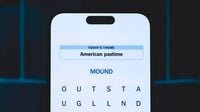On Saturday, November 15, 2025, puzzle enthusiasts across the globe found themselves peering through a particularly clever set of clues in the New York Times’ daily Strands game. The puzzle, numbered #622, arrived with the intriguing theme: “We can see right through them.” As with every Strands challenge, the goal was to uncover a set of interconnected words that fit the theme, plus a special word—dubbed the “spangram”—that ties the whole board together. And for those who spent their morning hunched over a digital grid of letters, this one was a real eye-opener.
According to Lifehacker, the November 15 Strands puzzle centered on objects that help us see, rather than things that are simply transparent. The spangram, which is the linchpin of each puzzle, was “EYETOEYE,” running a mix of vertical and diagonal across the board. The five theme words—GLASSES, LENSES, GOGGLES, BINOCULARS, and SPECTACLES—were all vision-enhancing accessories, each one a tool that literally allows us to see right through them. For those who got tripped up, the hints provided by various outlets were a lifeline: “The eyes have it,” as CNET put it, nudging solvers toward the correct line of thinking without giving too much away.
But what is Strands, and why has it become the latest obsession for fans of word puzzles? As Parade explains, Strands is the New York Times’ newest daily word game, joining the ranks of Wordle, Connections, and the Mini Crossword. Unlike its more straightforward predecessors, Strands asks players to find words hidden in a six-by-eight grid of letters. These words are always connected by a theme, and the spangram—often a phrase or compound word—spans the board, touching two opposite sides. Words can snake in any direction, even changing course midstream, and every letter in the grid is part of the solution. It’s a twist on the classic word search, but with layers of strategy and deduction that keep even seasoned solvers on their toes.
On this particular Saturday, the challenge lay in realizing that the theme wasn’t about “see-through” objects in the general sense—like glass or plastic—but rather items we use to enhance our own vision. As Lifehacker’s walkthrough noted, “GLASS isn’t a theme word, but GLASSES is.” That distinction was key, as it steered players away from the literal and toward the functional. The puzzle’s answers—GLASSES, LENSES, GOGGLES, BINOCULARS, SPECTACLES—each represent a different way of bringing the world into sharper focus, whether you’re reading a book, swimming underwater, or scanning the horizon for distant landmarks.
For those unfamiliar, the spangram is the most important word in every Strands puzzle. It’s the thread that ties the theme together, and it always stretches across the board, either horizontally, vertically, or diagonally. In this case, “EYETOEYE” summed up the day’s theme perfectly, evoking both the literal tools for sight and the idiomatic expression for agreement. As Parade pointed out, the spangram’s placement—a mix of vertical and diagonal—added an extra layer of challenge for solvers accustomed to more straightforward paths.
The New York Times’ own instructions, as cited by Parade, lay out the mechanics: “Find theme words to fill the board. Theme words stay highlighted in blue when found. Drag or tap letters to create words. If tapping, double-tap the last letter to submit. Theme words fill the board entirely. No theme words overlap.” The spangram, meanwhile, is highlighted in yellow when discovered. And if you get stuck? There’s a built-in hint system: every three non-theme words you find earns you a hint, revealing the letters in one of the theme words. It’s a system designed to encourage exploration, even for those who might not see the answer right away.
As CNET detailed, the puzzle’s structure means that every letter on the board is used exactly once, and there’s only one correct solution each day. Unlike other games, you can’t “fail” Strands—there’s no limit to the number of guesses, and no timer ticking down in the background. The goal is simply to find all the theme words and the spangram, using every letter on the board. When you do, you’re rewarded with a shareable card that marks your progress: blue dots for theme words, a yellow dot for the spangram, and a lightbulb for any words you solved with a hint.
The November 15 puzzle wasn’t the only recent challenge to stump solvers. As Mashable reported, the previous day’s Strands puzzle (November 14, 2025) revolved around the theme of visibility, with the hint “Low-key elusive.” The spangram, “Barely There,” was vertical, and the theme words included Nebulous, Faint, Understated, Subtle, and Tenuous. Each day’s puzzle brings a new twist, whether it’s about faintness, food wrappers, or dated slang, keeping the Strands community coming back for more.
For those who crave a deeper dive, Lifehacker and CNET both offer daily hints, walkthroughs, and even strategies for tackling the trickiest puzzles. They advise players to look for words that fit the theme, but also to experiment with any four-letter or longer words they find—since every three non-theme words unlock a hint, persistence pays off. And as The New York Times itself notes, the game is still in beta, meaning it’s being tested and refined based on player feedback. Its future, like that of Wordle before it, depends on whether enough solvers make it a daily habit.
The popularity of Strands speaks to the enduring appeal of word games, especially those that blend logic, language, and a dash of creativity. As the puzzles grow more challenging, players are finding community in online forums, sharing hints, strategies, and even commiserating over the toughest clues. And with each new theme, the game offers a fresh opportunity to see the world—and the English language—in a new light.
As Saturday’s “We can see right through them” puzzle proved, sometimes the clearest answers are the ones staring us right in the face. Whether you’re a word game veteran or a newcomer just looking for a morning brain boost, Strands continues to deliver a daily dose of delight, one letter at a time.


